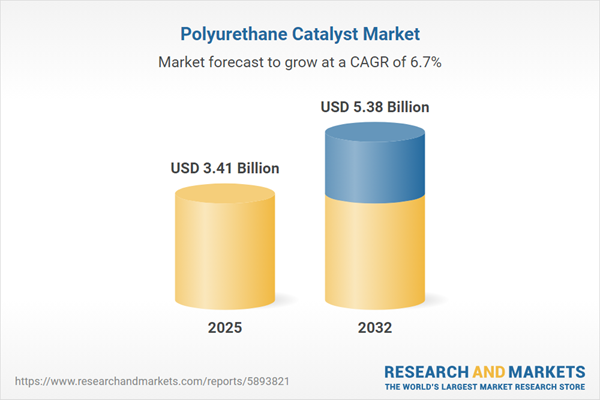Speak directly to the analyst to clarify any post sales queries you may have.
The polyurethane catalyst market is evolving rapidly, propelled by advanced catalyst technologies and increased focus on sustainability, regulatory compliance, and supply chain optimization. Stakeholders across industries are seeking reliable insights to drive strategic decisions and navigate disruptions in this specialized sector.
Market Snapshot: Polyurethane Catalyst Market Growth & Industry Context
The polyurethane catalyst market expanded from USD 3.21 billion in 2024 to USD 3.41 billion in 2025, with a projected CAGR of 6.67% expected to bring the market to USD 5.38 billion by 2032. Growth is supported by technological advances and strong demand across key verticals, including automotive, construction, and electronics. The market also reflects active adoption of eco-friendly formulations and robust R&D collaboration, as industry leaders adapt to evolving environmental regulations and regional compliance standards.
Scope & Segmentation: In-Depth Analysis Across Catalyst Ecosystem
This comprehensive report analyzes the polyurethane catalyst landscape across the following dimensions:
- Type: Amine Catalyst, Bismuth & Zinc Catalysts, Mercury Catalyst, Organo-Metallic Catalyst, Tin Catalysts
- Category: Blowing Catalyst, Crosslinking Catalysts, Curing Catalysts, Foam-Stabilization Catalyst, Gelling Catalyst
- Application: Adhesives & Sealants, Coatings, Elastomers, Flexible Foam, Foams
- End-Use Industry: Automotive, Construction, Electronics, Furniture & Bedding, Packaging, Textiles
- Region: Americas (North America, Latin America), Europe, Middle East & Africa, Asia-Pacific
- Company Coverage: Profiles and recent developments for Air Products and Chemicals, BASF SE, Covestro AG, Evonik Industries AG, Huntsman International LLC, Lanxess AG, The Dow Chemical Company, and others
Analysis encompasses technological innovation, regulatory landscape, supply chain resilience, and strategic responses to policy shifts across these critical segments.
Key Takeaways for Decision-Makers
- Technological convergence in polyurethane catalyst systems enables better reaction control, lower energy use, and reduced environmental impact, fueling industry transformation.
- Sustainability is a primary driver; manufacturers are prioritizing catalysts with minimized hazardous by-products and compliance with current and future regulations.
- End users in automotive, electronics, and construction sectors increasingly demand catalysts supporting sector-specific durability, rapid production cycles, and low emissions.
- Strategic supply chain flexibility and geographic diversification have become essential to manage tariff risks and maintain competitive pricing.
- Collaboration between chemical producers, research institutions, and end users fosters the development of bespoke, high-performance catalyst solutions aligned with dynamic market needs.
- Enhanced digitalization—such as predictive modeling and real-time monitoring—improves operational reliability and ensures consistent quality for large-scale producers.
Tariff Impact: Navigating 2025 U.S. Trade Measures
The introduction of U.S. tariffs on key polyurethane catalyst inputs in 2025 has directly influenced procurement strategies, with domestic and global producers reassessing sourcing and inventory practices. This policy shift encourages long-term partnerships with local suppliers and prompts increased investments in regional production capabilities. Supply chain adaptability remains vital as supplier networks explore alternatives outside tariff-affected areas and end-use industries adopt new hedging and inventory models to mitigate disruption.
Methodology & Data Sources
This analysis integrates secondary research from public and proprietary sources, including technical papers and patent filings, with primary insights from in-depth interviews with R&D leaders, procurement specialists, and regulatory stakeholders. Data triangulation and expert panel reviews validate findings, ensuring accuracy and relevance to current market realities.
Why This Report Matters
- Identify actionable opportunities and risks in the polyurethane catalyst market by leveraging detailed segmentation and regional intelligence.
- Support investment and sourcing decisions with fact-based analysis of innovation cycles, tariff impacts, and evolving regulatory frameworks.
- Benchmark leading suppliers and anticipate emerging industry shifts through comprehensive company profiles and competitive landscape mapping.
Conclusion
Senior leaders can use this report to anticipate market developments, optimize innovation strategies, and reinforce stakeholder value in an evolving polyurethane catalyst ecosystem. Informed decision-making will be essential to sustain long-term growth and navigate complexity within the sector.
Additional Product Information:
- Purchase of this report includes 1 year online access with quarterly updates.
- This report can be updated on request. Please contact our Customer Experience team using the Ask a Question widget on our website.
Table of Contents
3. Executive Summary
4. Market Overview
7. Cumulative Impact of Artificial Intelligence 2025
Companies Mentioned
The companies profiled in this Polyurethane Catalyst market report include:- Air Products and Chemicals, Inc.
- Alfa Chemicals
- BASF SE
- Biesterfeld AG
- Covestro AG
- DURA Chemicals, Inc.
- Evonik Industries AG
- Gulbrandsen
- Huntsman International LLC
- Kao Corporation
- Lanxess AG
- MAPEI S.p.A.
- Merck KGaA
- Mitsui Chemicals, Inc.
- Momentive Performance Materials Inc.
- PATCHAM
- SEHOTECH Inc.
- Shanghai Dimonds Chemical Technology Co., Ltd.
- Sinocure Chemical Group Co.,Limited
- Solvay S.A.
- The Chemours Company
- The Dow Chemical Company
- Tokyo Chemical Industry Co., Ltd.
- Tosoh Europe B.V.
- Umicore
Table Information
| Report Attribute | Details |
|---|---|
| No. of Pages | 193 |
| Published | November 2025 |
| Forecast Period | 2025 - 2032 |
| Estimated Market Value ( USD | $ 3.41 Billion |
| Forecasted Market Value ( USD | $ 5.38 Billion |
| Compound Annual Growth Rate | 6.6% |
| Regions Covered | Global |
| No. of Companies Mentioned | 26 |









